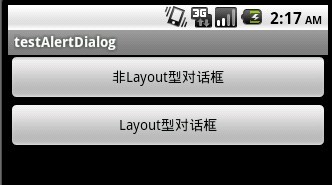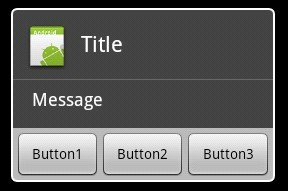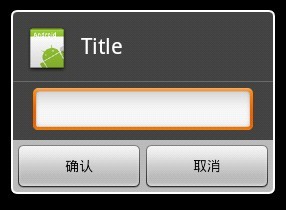Android的AlertDialog详解 自定义对话框
来源:互联网 发布:suse linux 最新版本 编辑:程序博客网 时间:2024/05/18 11:07
AlertDialog的构造方法全部是Protected的,所以不能直接通过new一个AlertDialog来创建出一个AlertDialog。
要创建一个AlertDialog,就要用到AlertDialog.Builder中的create()方法。
使用AlertDialog.Builder创建对话框需要了解以下几个方法:
setTitle :为对话框设置标题
setIcon :为对话框设置图标
setMessage:为对话框设置内容
setView : 给对话框设置自定义样式
setItems :设置对话框要显示的一个list,一般用于显示几个命令时
setMultiChoiceItems :用来设置对话框显示一系列的复选框
setNeutralButton :普通按钮
setPositiveButton :给对话框添加"Yes"按钮
setNegativeButton :对话框添加"No"按钮
create : 创建对话框
show :显示对话框
一、简单的AlertDialog
下面,创建一个简单的ALertDialog并显示它:
[java] package com.tianjf;
import android.app.Activity;
import android.app.AlertDialog;
import android.app.Dialog;
import android.os.Bundle;
public class Dialog_AlertDialogDemoActivity extends Activity {
/** Called when the activity is first created. */
@Override
public void onCreate(Bundle savedInstanceState) {
super.onCreate(savedInstanceState);
setContentView(R.layout.main);
Dialog alertDialog = new AlertDialog.Builder(this).
setTitle("对话框的标题").
setMessage("对话框的内容").
setIcon(R.drawable.ic_launcher).
create();
alertDialog.show();
}
}
package com.tianjf;
import android.app.Activity;
import android.app.AlertDialog;
import android.app.Dialog;
import android.os.Bundle;
public class Dialog_AlertDialogDemoActivity extends Activity {
/** Called when the activity is first created. */
@Override
public void onCreate(Bundle savedInstanceState) {
super.onCreate(savedInstanceState);
setContentView(R.layout.main);
Dialog alertDialog = new AlertDialog.Builder(this).
setTitle("对话框的标题").
setMessage("对话框的内容").
setIcon(R.drawable.ic_launcher).
create();
alertDialog.show();
}
}运行结果如下:

二、带按钮的AlertDialog
上面的例子很简单,下面我们在这个AlertDialog上面加几个Button,实现删除操作的提示对话框
[java] package com.tianjf;
import android.app.Activity;
import android.app.AlertDialog;
import android.app.Dialog;
import android.content.DialogInterface;
import android.os.Bundle;
public class Dialog_AlertDialogDemoActivity extends Activity {
/** Called when the activity is first created. */
@Override
public void onCreate(Bundle savedInstanceState) {
super.onCreate(savedInstanceState);
setContentView(R.layout.main);
Dialog alertDialog = new AlertDialog.Builder(this).
setTitle("确定删除?").
setMessage("您确定删除该条信息吗?").
setIcon(R.drawable.ic_launcher).
setPositiveButton("确定", new DialogInterface.OnClickListener() {
@Override
public void onClick(DialogInterface dialog, int which) {
// TODO Auto-generated method stub
}
}).
setNegativeButton("取消", new DialogInterface.OnClickListener() {
@Override
public void onClick(DialogInterface dialog, int which) {
// TODO Auto-generated method stub
}
}).
setNeutralButton("查看详情", new DialogInterface.OnClickListener() {
@Override
public void onClick(DialogInterface dialog, int which) {
// TODO Auto-generated method stub
}
}).
create();
alertDialog.show();
}
}
package com.tianjf;
import android.app.Activity;
import android.app.AlertDialog;
import android.app.Dialog;
import android.content.DialogInterface;
import android.os.Bundle;
public class Dialog_AlertDialogDemoActivity extends Activity {
/** Called when the activity is first created. */
@Override
public void onCreate(Bundle savedInstanceState) {
super.onCreate(savedInstanceState);
setContentView(R.layout.main);
Dialog alertDialog = new AlertDialog.Builder(this).
setTitle("确定删除?").
setMessage("您确定删除该条信息吗?").
setIcon(R.drawable.ic_launcher).
setPositiveButton("确定", new DialogInterface.OnClickListener() {
@Override
public void onClick(DialogInterface dialog, int which) {
// TODO Auto-generated method stub
}
}).
setNegativeButton("取消", new DialogInterface.OnClickListener() {
@Override
public void onClick(DialogInterface dialog, int which) {
// TODO Auto-generated method stub
}
}).
setNeutralButton("查看详情", new DialogInterface.OnClickListener() {
@Override
public void onClick(DialogInterface dialog, int which) {
// TODO Auto-generated method stub
}
}).
create();
alertDialog.show();
}
}在这个例子中,我们定义了三个按钮,分别是"Yes"按钮,"No"按钮以及一个普通按钮,每个按钮都有onClick事件,TODO的地方可以放点了按钮之后想要做的一些处理
看一下运行结果:

可以看到三个按钮添加到了AlertDialog上,三个没有添加事件处理的按钮,点了只是关闭对话框,没有任何其他操作。
三、类似ListView的AlertDialog
用setItems(CharSequence[] items, final OnClickListener listener)方法来实现类似ListView的AlertDialog
第一个参数是要显示的数据的数组,第二个参数是点击某个item的触发事件
[java] package com.tianjf;
import android.app.Activity;
import android.app.AlertDialog;
import android.app.Dialog;
import android.content.DialogInterface;
import android.os.Bundle;
import android.widget.Toast;
public class Dialog_AlertDialogDemoActivity extends Activity {
/** Called when the activity is first created. */
@Override
public void onCreate(Bundle savedInstanceState) {
super.onCreate(savedInstanceState);
setContentView(R.layout.main);
final String[] arrayFruit = new String[] { "苹果", "橘子", "草莓", "香蕉" };
Dialog alertDialog = new AlertDialog.Builder(this).
setTitle("你喜欢吃哪种水果?").
setIcon(R.drawable.ic_launcher)
.setItems(arrayFruit, new DialogInterface.OnClickListener() {
@Override
public void onClick(DialogInterface dialog, int which) {
Toast.makeText(Dialog_AlertDialogDemoActivity.this, arrayFruit[which], Toast.LENGTH_SHORT).show();
}
}).
setNegativeButton("取消", new DialogInterface.OnClickListener() {
@Override
public void onClick(DialogInterface dialog, int which) {
// TODO Auto-generated method stub
}
}).
create();
alertDialog.show();
}
}
package com.tianjf;
import android.app.Activity;
import android.app.AlertDialog;
import android.app.Dialog;
import android.content.DialogInterface;
import android.os.Bundle;
import android.widget.Toast;
public class Dialog_AlertDialogDemoActivity extends Activity {
/** Called when the activity is first created. */
@Override
public void onCreate(Bundle savedInstanceState) {
super.onCreate(savedInstanceState);
setContentView(R.layout.main);
final String[] arrayFruit = new String[] { "苹果", "橘子", "草莓", "香蕉" };
Dialog alertDialog = new AlertDialog.Builder(this).
setTitle("你喜欢吃哪种水果?").
setIcon(R.drawable.ic_launcher)
.setItems(arrayFruit, new DialogInterface.OnClickListener() {
@Override
public void onClick(DialogInterface dialog, int which) {
Toast.makeText(Dialog_AlertDialogDemoActivity.this, arrayFruit[which], Toast.LENGTH_SHORT).show();
}
}).
setNegativeButton("取消", new DialogInterface.OnClickListener() {
@Override
public void onClick(DialogInterface dialog, int which) {
// TODO Auto-generated method stub
}
}).
create();
alertDialog.show();
}
}运行结果如下:

四、类似RadioButton的AlertDialog
用setSingleChoiceItems(CharSequence[] items, int checkedItem, final OnClickListener listener)方法来实现类似RadioButton的AlertDialog
第一个参数是要显示的数据的数组,第二个参数是初始值(初始被选中的item),第三个参数是点击某个item的触发事件
在这个例子里面我们设了一个selectedFruitIndex用来记住选中的item的index
[java] package com.tianjf;
import android.app.Activity;
import android.app.AlertDialog;
import android.app.Dialog;
import android.content.DialogInterface;
import android.os.Bundle;
import android.widget.Toast;
public class Dialog_AlertDialogDemoActivity extends Activity {
private int selectedFruitIndex = 0;
/** Called when the activity is first created. */
@Override
public void onCreate(Bundle savedInstanceState) {
super.onCreate(savedInstanceState);
setContentView(R.layout.main);
final String[] arrayFruit = new String[] { "苹果", "橘子", "草莓", "香蕉" };
Dialog alertDialog = new AlertDialog.Builder(this).
setTitle("你喜欢吃哪种水果?").
setIcon(R.drawable.ic_launcher)
.setSingleChoiceItems(arrayFruit, 0, new DialogInterface.OnClickListener() {
@Override
public void onClick(DialogInterface dialog, int which) {
selectedFruitIndex = which;
}
}).
setPositiveButton("确认", new DialogInterface.OnClickListener() {
@Override
public void onClick(DialogInterface dialog, int which) {
Toast.makeText(Dialog_AlertDialogDemoActivity.this, arrayFruit[selectedFruitIndex], Toast.LENGTH_SHORT).show();
}
}).
setNegativeButton("取消", new DialogInterface.OnClickListener() {
@Override
public void onClick(DialogInterface dialog, int which) {
// TODO Auto-generated method stub
}
}).
create();
alertDialog.show();
}
}
package com.tianjf;
import android.app.Activity;
import android.app.AlertDialog;
import android.app.Dialog;
import android.content.DialogInterface;
import android.os.Bundle;
import android.widget.Toast;
public class Dialog_AlertDialogDemoActivity extends Activity {
private int selectedFruitIndex = 0;
/** Called when the activity is first created. */
@Override
public void onCreate(Bundle savedInstanceState) {
super.onCreate(savedInstanceState);
setContentView(R.layout.main);
final String[] arrayFruit = new String[] { "苹果", "橘子", "草莓", "香蕉" };
Dialog alertDialog = new AlertDialog.Builder(this).
setTitle("你喜欢吃哪种水果?").
setIcon(R.drawable.ic_launcher)
.setSingleChoiceItems(arrayFruit, 0, new DialogInterface.OnClickListener() {
@Override
public void onClick(DialogInterface dialog, int which) {
selectedFruitIndex = which;
}
}).
setPositiveButton("确认", new DialogInterface.OnClickListener() {
@Override
public void onClick(DialogInterface dialog, int which) {
Toast.makeText(Dialog_AlertDialogDemoActivity.this, arrayFruit[selectedFruitIndex], Toast.LENGTH_SHORT).show();
}
}).
setNegativeButton("取消", new DialogInterface.OnClickListener() {
@Override
public void onClick(DialogInterface dialog, int which) {
// TODO Auto-generated method stub
}
}).
create();
alertDialog.show();
}
}
运行结果如下:

五、类似CheckBox的AlertDialog
用setMultiChoiceItems(CharSequence[] items, boolean[] checkedItems, final OnMultiChoiceClickListener listener)方法来实现类似CheckBox的AlertDialog
第一个参数是要显示的数据的数组,第二个参数是选中状态的数组,第三个参数是点击某个item的触发事件
[java] package com.tianjf;
import android.app.Activity;
import android.app.AlertDialog;
import android.app.Dialog;
import android.content.DialogInterface;
import android.os.Bundle;
import android.widget.Toast;
public class Dialog_AlertDialogDemoActivity extends Activity {
/** Called when the activity is first created. */
@Override
public void onCreate(Bundle savedInstanceState) {
super.onCreate(savedInstanceState);
setContentView(R.layout.main);
final String[] arrayFruit = new String[] { "苹果", "橘子", "草莓", "香蕉" };
final boolean[] arrayFruitSelected = new boolean[] {true, true, false, false};
Dialog alertDialog = new AlertDialog.Builder(this).
setTitle("你喜欢吃哪种水果?").
setIcon(R.drawable.ic_launcher)
.setMultiChoiceItems(arrayFruit, arrayFruitSelected, new DialogInterface.OnMultiChoiceClickListener() {
@Override
public void onClick(DialogInterface dialog, int which, boolean isChecked) {
arrayFruitSelected[which] = isChecked;
}
}).
setPositiveButton("确认", new DialogInterface.OnClickListener() {
@Override
public void onClick(DialogInterface dialog, int which) {
StringBuilder stringBuilder = new StringBuilder();
for (int i = 0; i < arrayFruitSelected.length; i++) {
if (arrayFruitSelected[i] == true)
{
stringBuilder.append(arrayFruit[i] + "、");
}
}
Toast.makeText(Dialog_AlertDialogDemoActivity.this, stringBuilder.toString(), Toast.LENGTH_SHORT).show();
}
}).
setNegativeButton("取消", new DialogInterface.OnClickListener() {
@Override
public void onClick(DialogInterface dialog, int which) {
// TODO Auto-generated method stub
}
}).
create();
alertDialog.show();
}
}
package com.tianjf;
import android.app.Activity;
import android.app.AlertDialog;
import android.app.Dialog;
import android.content.DialogInterface;
import android.os.Bundle;
import android.widget.Toast;
public class Dialog_AlertDialogDemoActivity extends Activity {
/** Called when the activity is first created. */
@Override
public void onCreate(Bundle savedInstanceState) {
super.onCreate(savedInstanceState);
setContentView(R.layout.main);
final String[] arrayFruit = new String[] { "苹果", "橘子", "草莓", "香蕉" };
final boolean[] arrayFruitSelected = new boolean[] {true, true, false, false};
Dialog alertDialog = new AlertDialog.Builder(this).
setTitle("你喜欢吃哪种水果?").
setIcon(R.drawable.ic_launcher)
.setMultiChoiceItems(arrayFruit, arrayFruitSelected, new DialogInterface.OnMultiChoiceClickListener() {
@Override
public void onClick(DialogInterface dialog, int which, boolean isChecked) {
arrayFruitSelected[which] = isChecked;
}
}).
setPositiveButton("确认", new DialogInterface.OnClickListener() {
@Override
public void onClick(DialogInterface dialog, int which) {
StringBuilder stringBuilder = new StringBuilder();
for (int i = 0; i < arrayFruitSelected.length; i++) {
if (arrayFruitSelected[i] == true)
{
stringBuilder.append(arrayFruit[i] + "、");
}
}
Toast.makeText(Dialog_AlertDialogDemoActivity.this, stringBuilder.toString(), Toast.LENGTH_SHORT).show();
}
}).
setNegativeButton("取消", new DialogInterface.OnClickListener() {
@Override
public void onClick(DialogInterface dialog, int which) {
// TODO Auto-generated method stub
}
}).
create();
alertDialog.show();
}
}运行结果如下:

六、自定义View的AlertDialog
有时候我们不能满足系统自带的AlertDialog风格,就比如说我们要实现一个Login画面,有用户名和密码,这时我们就要用到自定义View的AlertDialog
先创建Login画面的布局文件
[html] <?xml version="1.0" encoding="utf-8"?>
<LinearLayout xmlns:android="http://schemas.android.com/apk/res/android"
android:layout_width="fill_parent"
android:layout_height="fill_parent"
android:orientation="vertical" >
<LinearLayout
android:layout_width="fill_parent"
android:layout_height="wrap_content"
android:gravity="center" >
<TextView
android:layout_width="0dip"
android:layout_height="wrap_content"
android:layout_weight="1"
android:text="@string/user" />
<EditText
android:layout_width="0dip"
android:layout_height="wrap_content"
android:layout_weight="1" />
</LinearLayout>
<LinearLayout
android:layout_width="fill_parent"
android:layout_height="wrap_content"
android:gravity="center" >
<TextView
android:layout_width="0dip"
android:layout_height="wrap_content"
android:layout_weight="1"
android:text="@string/passward" />
<EditText
android:layout_width="0dip"
android:layout_height="wrap_content"
android:layout_weight="1" />
</LinearLayout>
</LinearLayout>
<?xml version="1.0" encoding="utf-8"?>
<LinearLayout xmlns:android="http://schemas.android.com/apk/res/android"
android:layout_width="fill_parent"
android:layout_height="fill_parent"
android:orientation="vertical" >
<LinearLayout
android:layout_width="fill_parent"
android:layout_height="wrap_content"
android:gravity="center" >
<TextView
android:layout_width="0dip"
android:layout_height="wrap_content"
android:layout_weight="1"
android:text="@string/user" />
<EditText
android:layout_width="0dip"
android:layout_height="wrap_content"
android:layout_weight="1" />
</LinearLayout>
<LinearLayout
android:layout_width="fill_parent"
android:layout_height="wrap_content"
android:gravity="center" >
<TextView
android:layout_width="0dip"
android:layout_height="wrap_content"
android:layout_weight="1"
android:text="@string/passward" />
<EditText
android:layout_width="0dip"
android:layout_height="wrap_content"
android:layout_weight="1" />
</LinearLayout>
</LinearLayout>
然后在Activity里面把Login画面的布局文件添加到AlertDialog上
[java] package com.tianjf;
import android.app.Activity;
import android.app.AlertDialog;
import android.app.Dialog;
import android.content.DialogInterface;
import android.os.Bundle;
import android.view.LayoutInflater;
import android.view.View;
public class Dialog_AlertDialogDemoActivity extends Activity {
/** Called when the activity is first created. */
@Override
public void onCreate(Bundle savedInstanceState) {
super.onCreate(savedInstanceState);
setContentView(R.layout.main);
// 取得自定义View
LayoutInflater layoutInflater = LayoutInflater.from(this);
View myLoginView = layoutInflater.inflate(R.layout.login, null);
Dialog alertDialog = new AlertDialog.Builder(this).
setTitle("用户登录").
setIcon(R.drawable.ic_launcher).
setView(myLoginView).
setPositiveButton("登录", new DialogInterface.OnClickListener() {
@Override
public void onClick(DialogInterface dialog, int which) {
// TODO Auto-generated method stub
}
}).
setNegativeButton("取消", new DialogInterface.OnClickListener() {
@Override
public void onClick(DialogInterface dialog, int which) {
// TODO Auto-generated method stub
}
}).
create();
alertDialog.show();
}
}
package com.tianjf;
import android.app.Activity;
import android.app.AlertDialog;
import android.app.Dialog;
import android.content.DialogInterface;
import android.os.Bundle;
import android.view.LayoutInflater;
import android.view.View;
public class Dialog_AlertDialogDemoActivity extends Activity {
/** Called when the activity is first created. */
@Override
public void onCreate(Bundle savedInstanceState) {
super.onCreate(savedInstanceState);
setContentView(R.layout.main);
// 取得自定义View
LayoutInflater layoutInflater = LayoutInflater.from(this);
View myLoginView = layoutInflater.inflate(R.layout.login, null);
Dialog alertDialog = new AlertDialog.Builder(this).
setTitle("用户登录").
setIcon(R.drawable.ic_launcher).
setView(myLoginView).
setPositiveButton("登录", new DialogInterface.OnClickListener() {
@Override
public void onClick(DialogInterface dialog, int which) {
// TODO Auto-generated method stub
}
}).
setNegativeButton("取消", new DialogInterface.OnClickListener() {
@Override
public void onClick(DialogInterface dialog, int which) {
// TODO Auto-generated method stub
}
}).
create();
alertDialog.show();
}
}运行结果如下:

非阻塞的,而阻塞的对话框用的是PopupWindow。
先贴出程序运行的截图:

main.xml的源码:
- <?xml version="1.0" encoding="utf-8"?>
- <LinearLayout xmlns:android="http://schemas.android.com/apk/res/android"
- android:orientation="vertical"
- android:layout_width="fill_parent"
- android:layout_height="fill_parent"
- >
- <Button android:id="@+id/Button01" android:layout_height="wrap_content" android:text="非Layout型对话框" android:layout_width="fill_parent"></Button>
- <Button android:id="@+id/Button02" android:layout_height="wrap_content" android:text="Layout型对话框" android:layout_width="fill_parent"></Button><View android:id="@+id/View01" android:layout_width="wrap_content" android:layout_height="wrap_content"></View>
- </LinearLayout>
下图是非Layout型对话框,直接使用AlertDialog

下图是使用了Layout的对话框,可以自定义控件,实现更复杂的对话框

dialoglayout.xml的源码:
- <?xml version="1.0" encoding="utf-8"?>
- <LinearLayout xmlns:android="http://schemas.android.com/apk/res/android"
- android:layout_width="fill_parent" android:layout_height="wrap_content"
- android:orientation="vertical">
- <EditText android:layout_height="wrap_content"
- android:layout_width="fill_parent" android:layout_marginLeft="20dip"
- android:layout_marginRight="20dip" android:textAppearance="?android:attr/textAppearanceMedium" android:id="@+id/edtInput"/>
- </LinearLayout>
程序源码:
- package com.testAlertDialog;
- import android.app.Activity;
- import android.app.AlertDialog;
- import android.content.Context;
- import android.content.DialogInterface;
- import android.os.Bundle;
- import android.view.Gravity;
- import android.view.LayoutInflater;
- import android.view.View;
- import android.view.View.OnClickListener;
- import android.widget.Button;
- import android.widget.EditText;
- import android.widget.PopupWindow;
- public class testAlertDialog extends Activity {
- Button btnShowDialog;
- Button btnShowDialog_Layout;
- /** Called when the activity is first created. */
- @Override
- public void onCreate(Bundle savedInstanceState) {
- super.onCreate(savedInstanceState);
- setContentView(R.layout.main);
- //定义按钮
- btnShowDialog=(Button)this.findViewById(R.id.Button01);
- btnShowDialog.setOnClickListener(new ClickEvent());
- btnShowDialog_Layout=(Button)this.findViewById(R.id.Button02);
- btnShowDialog_Layout.setOnClickListener(new ClickEvent());
- }
- //统一处理按键事件
- class ClickEvent implements OnClickListener{
- @Override
- public void onClick(View v) {
- // TODO Auto-generated method stub
- if(v==btnShowDialog)
- showDialog(testAlertDialog.this);
- else if(v==btnShowDialog_Layout)
- showDialog_Layout(testAlertDialog.this);
- }
- }
- //显示基本的AlertDialog
- private void showDialog(Context context) {
- AlertDialog.Builder builder = new AlertDialog.Builder(context);
- builder.setIcon(R.drawable.icon);
- builder.setTitle("Title");
- builder.setMessage("Message");
- builder.setPositiveButton("Button1",
- new DialogInterface.OnClickListener() {
- public void onClick(DialogInterface dialog, int whichButton) {
- setTitle("点击了对话框上的Button1");
- }
- });
- builder.setNeutralButton("Button2",
- new DialogInterface.OnClickListener() {
- public void onClick(DialogInterface dialog, int whichButton) {
- setTitle("点击了对话框上的Button2");
- }
- });
- builder.setNegativeButton("Button3",
- new DialogInterface.OnClickListener() {
- public void onClick(DialogInterface dialog, int whichButton) {
- setTitle("点击了对话框上的Button3");
- }
- });
- builder.show();
- }
- //显示基于Layout的AlertDialog
- private void showDialog_Layout(Context context) {
- LayoutInflater inflater = LayoutInflater.from(this);
- final View textEntryView = inflater.inflate(
- R.layout.dialoglayout, null);
- final EditText edtInput=(EditText)textEntryView.findViewById(R.id.edtInput);
- final AlertDialog.Builder builder = new AlertDialog.Builder(context);
- builder.setCancelable(false);
- builder.setIcon(R.drawable.icon);
- builder.setTitle("Title");
- builder.setView(textEntryView);
- builder.setPositiveButton("确认",
- new DialogInterface.OnClickListener() {
- public void onClick(DialogInterface dialog, int whichButton) {
- setTitle(edtInput.getText());
- }
- });
- builder.setNegativeButton("取消",
- new DialogInterface.OnClickListener() {
- public void onClick(DialogInterface dialog, int whichButton) {
- setTitle("");
}
});
builder.show();
}
}
- Android的AlertDialog详解 自定义对话框
- Android 自定义AlertDialog对话框
- android,Alertdialog,自定义对话框
- Android--自定义对话框--AlertDialog
- 自定义 Android 对话框 (AlertDialog) 的样式
- 完全自定义Android对话框AlertDialog的实现
- 自定义 Android 对话框 (AlertDialog) 的样式
- 自定义 Android 对话框 (AlertDialog) 的样式
- 自定义 Android 对话框 (AlertDialog) 的样式
- 自定义 Android 对话框 (AlertDialog) 的样式
- 自定义 Android 对话框 (AlertDialog) 的样式
- 自定义 Android 对话框 (AlertDialog) 的样式
- 自定义 Android 对话框 (AlertDialog) 的样式
- 自定义 Android 对话框 (AlertDialog) 的样式
- 完全自定义Android对话框AlertDialog的实现
- 自定义 Android 对话框 (AlertDialog) 的样式
- 自定义 Android 对话框 (AlertDialog) 的样式
- 自定义 Android 对话框 (AlertDialog) 的样式
- js各种距离区分
- 命令行玩转阿里云OSS
- 欢迎使用CSDN-markdown编辑器
- Cocos2d-x 3.x版2048游戏开发
- MySQL学习笔记6(触发器)
- Android的AlertDialog详解 自定义对话框
- Java泛型限制Demo3
- 常用数学符号读法及其含义
- Java 显示 使用中的内存
- 4.设计与声明
- Hive SQL的编译过程_美团技术点评
- 动态内存简介
- 记 BestCoder Round #75
- Java学习笔记——1


